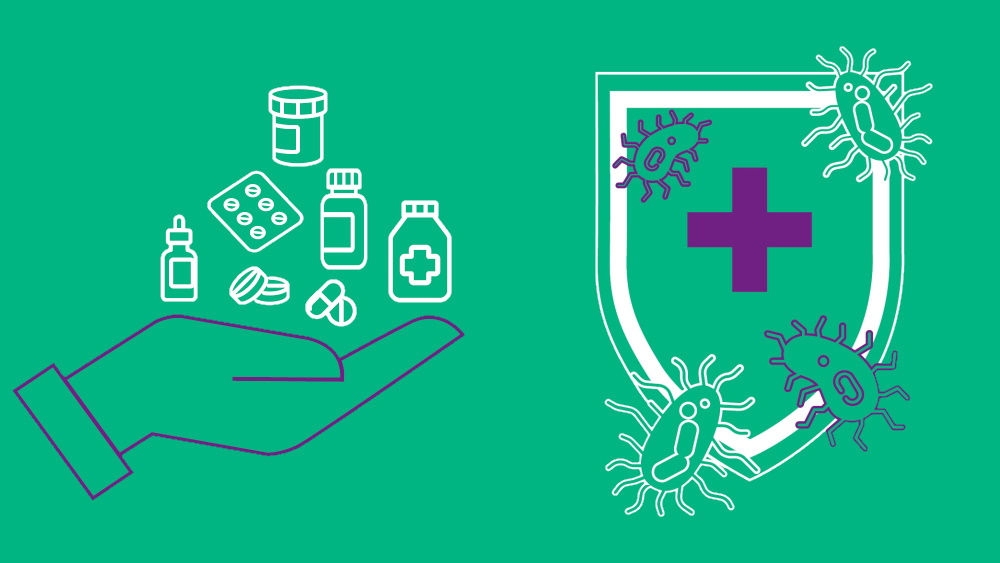No content results match your keyword.
Content
You have successfully logged out.
Not registered yet?
Alternative to antibiotics in wound care
In developed countries, it has been estimated that 1 to 2 percent of the population will experience a chronic wound during their lifetime. The burden of chronic wounds and wound treatment is rapidly growing.[1] Wound infections can compromise the healing process and let wounds develop into chronic wounds, with a significant negative impact on health-related quality of life.[2,3] Even worse, they bear the risk of amputation and lethal sepsis.[4] Additionally, infected wounds provide a great burden to the healthcare system.[2,3]
It is of mayor importance to find the best strategy to prevent, diagnose and manage wound infections.
More than
0%
of chronic wounds are estimated to be infected.[5,6]
Up to
0%
of chronic wounds contain biofilm with a role in wound infection.[7,8,9,10]
Chronic wounds
The wound infection continuum looks at the different stages of wound infection progressing from initial contamination up to overt sepsis.[11,12] This concept can help wound care practitioners to find the best strategy to prevent, diagnose and manage wound infection. Get to know our therapy concept that covers all stages of the wound infection continuum: Prontosan® to prevent the formation of biofilm and to decrease the bacterial burden, and Askina® Calgitrol®, a range of silver wound dressings, which provides an ancillary antimicrobial activity and helps prevent contamination from external bacteria.

A thorough wound assessment is essential for preventing and treating wound infections and all types of complications that can accompany them.[13,14] Proper diagnosis and product selection strategies can help you prevent and treat wound infections. Prontosan® and Askina® Calgitrol® make a great match in the combat against wound infections.
This combination has helped to restore health to the patient Miguel whose clinical case history was presented during our symposium at EWMA 2022 to provide practical insights. In this symposium, we focused on the importance of recognizing the signs of a developing wound infection and how to assess them using the Wound Infection Continuum.
Your choice matters – how would you have treated Miguel’s wound? We invite you to watch our symposium video.
Expert opinion
The following case studies were carried out to evaluate the efficacy of a biofilm remover/cleanser in gel form - Prontosan® together with the use of an ionic releasing silver alginate - Askina® Calgitrol® Paste or Askina® Calgitrol® Thin - when used on infected wounds.
All wounds showed a significant reduction in terms of clinical signs of infection within the first week of treatment. Some 50% of all wound infections were completely resolved by week 2. Eighty-one per cent of all wounds had no clinical signs of infection in less than 3 weeks. None of the patients were given any oral or intravenous antibiotics while on the study; all patients were only treated by using local antimicrobials. There was also a decrease in odour in all wounds.
Read the complete case reportWound infections are caused by the deposit and profileration of microorganisms in the surgical site of a susceptible host. There are numerous ways microorganisms can enter the wound bed. The infection can result in sepsis when bacteria spreads into the blood stream, called bacteriemia, which can turn into life-threatening sepsis with multi-organ failure.[15]
The main objective is to prevent infections rather than to treat them.
In contact with the wound exudate, Askina® Calgitrol® dressing releases antimicrobial silver. Simultaneously, it maintains a moist wound environment conducive to natural healing conditions and helps prevent contamination from external bacteria.[16]
Learn more about silver dressingsOver- and misuse of antibiotics in medicine are known to have mainly contributed to the problem. As a result, AMR emerges as an progressive risk for global public health and has been appraised as the highest health endangerment in the 21st century.[17,18]

If an effective action plan is not implemented, the annual death rate is expected to reach 10 million deaths per year by 2050.[19,20]
The loss of capital caused by antimicrobial resistance is globally estimated to be approximately $300 billion to $1 trillion by 2050.[17]
Help to implement a strategy to avoid the overuse of antibiotics and thus slow down antimicrobial resistance.
Your feedback matters! Participate in our customer survey to help us enhance our website, products and services. Thank you for your support!